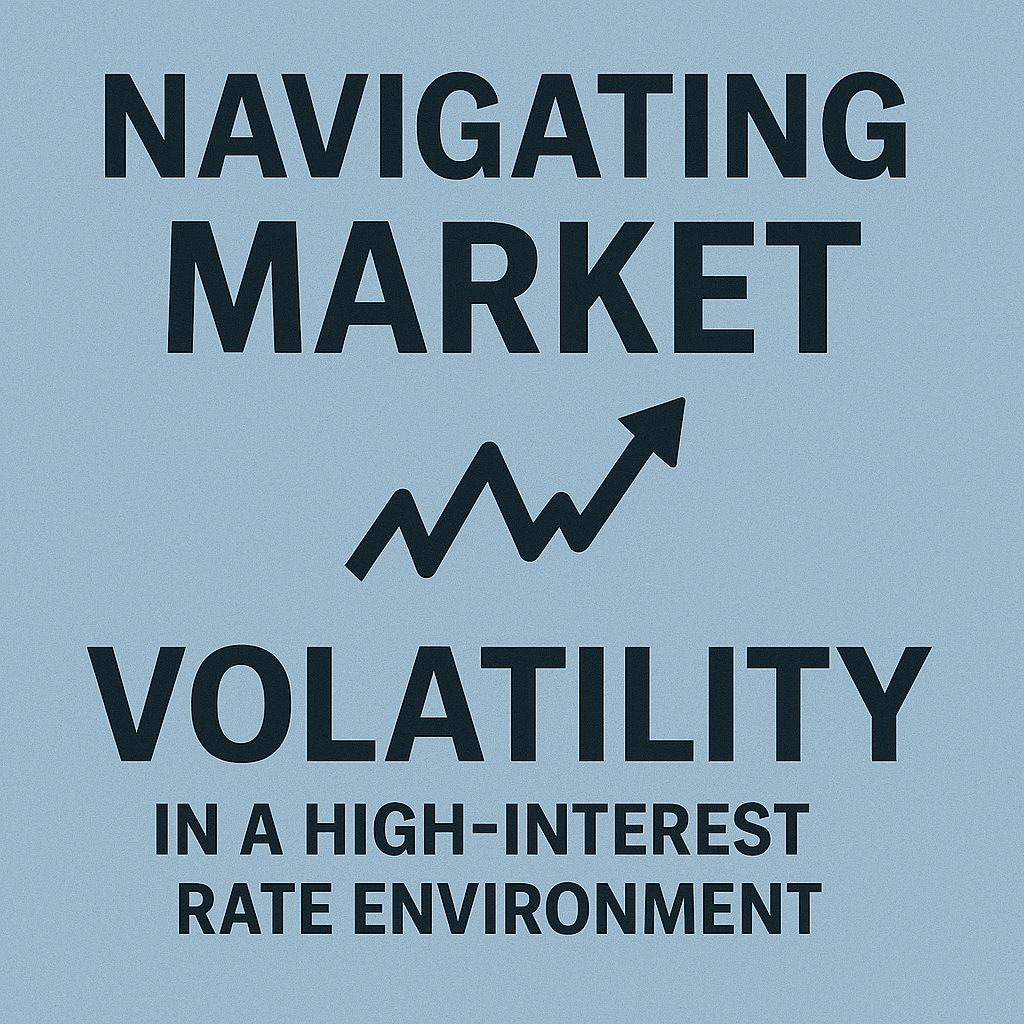Your cart is currently empty!
Navigating Market Volatility in a High-Interest Rate Environment

Navigating market volatility refers to the degree of variation in the price of financial instruments over time. In a high-interest rate environment, volatility tends to increase, making financial markets more unpredictable. This often creates both opportunities and risks for investors—especially beginners who may be new to these market dynamics.
The rise in interest rates generally reflects central bank policies aiming to curb inflation or stabilize overheating economies. While these policy decisions are crucial from a macroeconomic perspective, they create fluctuations in asset prices, consumer spending, corporate profits, and even foreign exchange rates. For beginners in the United States, United Kingdom, Italy, and across Europe, learning to navigate market volatility becomes essential in protecting and growing investments.
This guide offers foundational knowledge to help new investors manage uncertainty in high-rate scenarios. From understanding interest rate mechanisms to adopting practical investment strategies, this article is tailored for the modern investor.
How Interest Rates Impact Financial Markets
Interest rates affect almost every aspect of the financial ecosystem. When central banks such as the Federal Reserve, Bank of England, or European Central Bank raise interest rates, borrowing becomes more expensive. This impacts both corporate and consumer spending, which in turn affects company revenues and stock market performance.
For instance, higher interest rates can lead to:
- Decreased corporate profits due to expensive financing.
- Lower consumer demand for goods and services.
- A reduction in real estate prices as mortgage rates climb.
- Increased yields on bonds, making them more attractive than stocks.
- Currency appreciation, which can affect international trade balances.
In such an environment, investors often shift their portfolios toward safer or income-generating assets. For beginners, understanding these shifts is critical to making informed decisions.
The Psychology of Market Volatility
When markets become volatile, human emotions often interfere with rational investing. Fear, uncertainty, and the herd mentality can cause beginners to sell at lows and buy at highs. Recognizing this pattern is the first step in avoiding poor investment choices.
In a high-interest rate environment, daily price swings are amplified by investor sentiment. News headlines, economic data releases, and central bank statements can significantly affect market direction. Maintaining a long-term perspective and avoiding impulsive decisions is key.
If you’re just starting out, it’s vital to develop emotional discipline. Volatility is not inherently bad—it simply reflects shifting market expectations. With the right strategy, beginners can use volatility to their advantage rather than becoming victims of it.
Building a Beginner-Friendly Portfolio
One of the best ways to handle volatility in a high-interest rate environment is by constructing a resilient portfolio. For beginners, this means diversifying across asset classes and geographic regions. A well-balanced portfolio helps reduce exposure to any one asset or market.
In times of high interest rates, fixed-income investments such as government and corporate bonds often become more appealing. Dividend-paying stocks, real estate investment trusts (REITs), and commodities like gold may also offer stability.
Dollar-cost averaging can be a practical method for new investors. This strategy involves investing a fixed amount at regular intervals, regardless of market conditions. It helps mitigate the risk of investing a large sum at an inopportune moment and smoothens out market fluctuations over time.
Risk Management Strategies for Volatile Markets
Navigating market volatility requires more than just choosing the right assets. Beginners should also adopt risk management strategies to protect their portfolios.
Stop-loss orders, for example, automatically sell a security when it drops below a set price. This helps limit potential losses. Hedging with options or other derivatives may also be suitable for more advanced beginners under proper guidance.
In high-interest rate conditions, holding cash reserves is another effective strategy. It provides liquidity and the flexibility to invest when opportunities arise without being forced to sell existing holdings at a loss.
Understanding your risk tolerance is equally important. Beginners should assess how much loss they can endure without panic. This helps in determining asset allocation and the choice of investment vehicles.
The Role of Central Banks and Monetary Policy
To better navigate a high-interest rate environment, it’s essential to understand the role of central banks. Institutions like the Federal Reserve, Bank of England, and European Central Bank use interest rates as a tool to manage inflation, economic growth, and employment levels.
When inflation rises, central banks increase interest rates to reduce spending and borrowing. Conversely, they lower rates to stimulate growth when the economy slows. These decisions ripple across stock markets, bond yields, and even real estate sectors.
For beginners in the US, UK, Italy, and Europe, tracking central bank policies can offer valuable insights. Monetary policy updates and meeting minutes are publicly available and often covered by major financial news platforms.
Being aware of scheduled announcements and understanding the language used in monetary statements will help beginners anticipate market reactions and adjust their strategies accordingly.
Economic Indicators to Watch
In a volatile market environment, certain economic indicators become especially important. These metrics help investors predict how interest rates might change and how markets may react.
Key indicators include:
- Consumer Price Index (CPI): Measures inflation.
- Gross Domestic Product (GDP): Reflects economic growth.
- Unemployment Rate: Indicates the health of the labour market.
- Purchasing Managers’ Index (PMI): Gauges business activity.
- Retail Sales: Tracks consumer spending trends.
For beginners, paying attention to these indicators can help build context around market movements. Many of these metrics are released monthly and can cause immediate volatility, especially in a high-interest rate environment.
Global Impact of High Interest Rates
Interest rates do not exist in isolation. A hike in the United States can influence bond yields, currency values, and capital flows globally. UK and European markets often react to US Federal Reserve decisions, and vice versa.
For beginners in Italy and other EU nations, it’s important to realize that monetary tightening in one country can trigger broader financial shifts. For instance, rising US interest rates may strengthen the dollar, weakening the euro and making imports more expensive in Europe.
Currency fluctuations can also affect the value of foreign investments. Understanding these interdependencies helps investors take a more holistic approach to portfolio management.
Staying Informed and Educated
Market volatility can be intimidating, but staying informed is a powerful tool for beginners. Following reputable financial news sources, subscribing to newsletters, and participating in webinars or online courses can improve your financial literacy.
Many platforms now offer beginner-friendly investment guides and simulation tools to help you practice trading strategies without real capital. Knowledge is the best defense against poor decisions in a high-interest rate environment.
Astute investors also read market commentary by professionals. Platforms like RajeevPrakash.com regularly provide updates and insights tailored to market movements and economic conditions.
Practical Steps Beginners Can Take Today
Even without advanced tools or years of experience, beginners can take immediate steps to navigate volatility:
Start by setting clear financial goals and defining your investment timeline. Are you saving for retirement, a home, or short-term returns? Your objectives will influence your risk tolerance and investment choices.
Next, create a budget that allows for consistent investment without compromising daily expenses. High-interest rate environments can affect job security and income stability, so maintaining an emergency fund is essential.
Finally, consult with certified financial advisors or use robo-advisory services that tailor portfolios based on your profile. These platforms often factor in interest rate changes and market volatility when managing funds.
Conclusion: Embracing Volatility with Confidence
Navigating market volatility in a high-interest rate environment may seem daunting at first. But for beginners across the US, UK, Italy, and Europe, the right knowledge and strategies can make all the difference.
Instead of fearing volatility, embrace it as a natural part of the market cycle. High-interest rate conditions are not permanent, and with a well-planned approach, you can protect your capital, seize opportunities, and build long-term wealth.
Start small, stay consistent, and keep learning. With patience and discipline, navigating these turbulent times can become a rewarding experience.

Mr. Rajeev Prakash
Rajeev is a well-known astrologer based in central India who has a deep understanding of both personal and mundane astrology. His team has been closely monitoring the movements of various global financial markets, including equities, precious metals, currency pairs, yields, and treasury bonds.
Featured Post
Financial Astrology Terminal
The Financial Astrology Terminal is a web platform that combines real-time U.S. market data (S&P 500, Nasdaq, Dow, Russell, key stocks and commodities like gold and silver) with planetary cycles, giving traders and investors astro-timing signals on top of normal charts and analysis.
